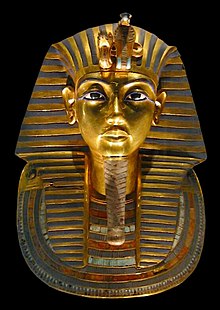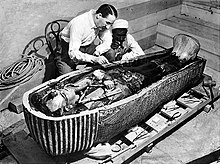
Back Toetankamen Afrikaans توت عنخ آمون Arabic توت عنخ امون ARZ Tutankamón AST Tutanxamon Azerbaijani توت انخ آمون AZB Тутанхамон Bashkir Tutankhamun BCL Тутанхамон Byelorussian Тутанхамон BE-X-OLD


Tutankhamun (Tutankhaten, Tutankhamun) was an Egyptian Pharaoh of the 18th dynasty (royal family) during the New Kingdom.[1] He reigned from when he was nine years old (1334 BC) to when he died (1324 BC).
Tutankhamun was the son of Akhenaten and one of Akhenaten's sisters,[2] or perhaps one of his cousins, Kiya.[3] Tutankhamun ruled for 9 years and died very young, at 19, so he is known as The Boy King. He was married to his half-sister Ankhesenamun, daughter of Queen Nefertiti, his stepmother.


In his third year of his reign, Tutankhamun reversed several changes made during his father's reign. He ended the worship of the god Aten and restored the god Amun to supremacy. The ban on the cult of Amun was lifted and traditional privileges were restored to its priesthood. The capital was moved back to Thebes and the city of Akhenaten abandoned.[4] This is when he changed his name to Tutankhamun, "Living image of Amun", reinforcing the restoration of Amun.
In 1922 Howard Carter found Tutankhamun's tomb. Tutankhamen was believed to carry a curse. Actually, the archeologists who visited his tomb died from natural causes. Tutankhamen's tomb's unique and priceless treasures have taught us a lot about the boy king, the pharaohs, and ancient Egypt.[5]
- ↑ Clayton, Peter A. 2006. Chronicle of the Pharaohs: the reign-by-reign record of the rulers and dynasties of Ancient Egypt. Thames & Hudson. ISBN 978-0-500-28628-9
- ↑ Hawass, Zahi; et al. (2010). "Ancestry and Pathology in King Tutankhamun's Family". Journal of the American Medical Association. 303 (7): 640–641. Retrieved 21 October 2013.
- ↑ Powell, Alvin (12 February 2013). "A different take on Tut". Harvard Gazette.
- ↑ Erik Hornung, Akhenaten and the religion of light, Translated by David Lorton, Ithaca, New York: Cornell University Press, 2001, ISBN 0-8014-8725-0.
- ↑ "3.3 History Through Objects: Tut's Treasures". Retrieved 2023-02-04.